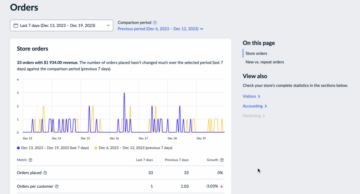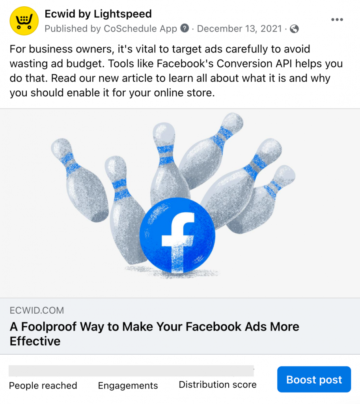
Running an online store is a great way to grow revenue and reach more customers… But why stop there? Expanding to online marketplaces can give you access to even more potential customers and increase sales!
In this podcast, we’ll explore the advice of Ben Jones from Codisto on how to maximize success when expanding to services like Amazon, eBay, and Walmart. If you’re looking to grow your revenue, this podcast will help you make the most out of the opportunities offered by online marketplaces.
Why You Should Go Omnichannel
If you’ve been operating an online store, but have been primarily selling on your website and social media while running Facebook and Google ads to market, you know these channels eventually begin to tap out. You’re seeing a plateau in website traffic and orders. So, what’s the next step? You need to find new customers and drive more traffic.
Expanding to marketplaces becomes the next logical step in your growth journey.
If you really want to increase sales, you need to go omnichannel. That means being present for your customers no matter where they prefer to shop. Some people only shop on Amazon, while other customers like to shop directly with the brand because they prefer that experience. Some people will shop on eBay because they want to find a good deal.
Regardless of what strategies you might be activating, you need to sell your products wherever your customers are choosing to shop.
Increasing Your Brand Visibility with Marketplaces
Increased product discovery is a good reason to work with marketplaces. It costs a lot of money to advertise on Google and Facebook to reach new customers. A marketplace has a different model. They have advertising options if you want to boost your listings with some paid promotion. But also, your brand will be organically discovered by people that prefer to shop on marketplaces only—shoppers that you normally wouldn’t reach.
What Marketplace Should You Choose?
Amazon, eBay, and Walmart are some of the most popular online marketplaces. Keep in mind their specific guidelines when choosing a marketplace to sell your products.
Amazon is definitely the most popular online marketplace in the US: 61% of US consumers begin their product search on Amazon. That’s more searches than on a search engine like Google!
eBay is mostly associated with selling secondhand goods, vintage, and collectible items.
As for Walmart, it has a similar value proposition to Amazon. However, it’s a younger online marketplace, so it’s far less competitive than Amazon.
Even though these marketplaces differ, Ben Jones sees value in every marketplace for every business and encourages you to sell everywhere.
For example, you can use eBay as a clearance channel to sell deadstock at a sale price. At the same time, you can sell your bestsellers on Amazon and test the waters on the less competitive Walmart marketplace.
Sell on Marketplaces with Codisto
In this episode, Ben Jones gives an overview of Codisto, a service that allows you to go omnichannel and sync your Ecwid store to marketplaces to sell on several platforms at once.
Your product details, pricing, and inventory are synced in real-time between your Ecwid store and connected marketplaces. This way, you don’t have to worry about overselling or changing product details on all platforms manually. You can also set up different prices on different marketplaces, which is useful to cover fees specific to certain platforms.
Check out our Help Center to find out how to connect your Ecwid store to marketplaces.
Listen to the full episode to learn more about getting started with marketplaces and making sure you see results soon after you launch your products on new platforms.
- SEO Powered Content & PR Distribution. Get Amplified Today.
- Platoblockchain. Web3 Metaverse Intelligence. Knowledge Amplified. Access Here.
- Source: https://www.ecwid.com/blog/how-to-expand-to-online-marketplaces-as-a-small-business-owner.html
- a
- About
- access
- activating
- Ads
- Advertise
- Advertising
- advice
- After
- All
- allows
- Amazon
- ARE
- AS
- associated
- because
- becomes
- begin
- being
- between
- boost
- brand
- business
- business owner
- CAN
- certain
- changing
- Channel
- channels
- Choose
- choosing
- Collectible
- competitive
- Connect
- connected
- Consumers
- Costs
- cover
- Customers
- deal
- definitely
- details
- differ
- different
- directly
- discovered
- discovery
- Dont
- drive
- eBay
- encourages
- Engine
- Even
- eventually
- Every
- example
- Expand
- expanding
- experience
- explore
- far
- Fees
- Find
- from
- full
- getting
- Give
- gives
- good
- goods
- Google ads
- great
- Grow
- Growth
- guidelines
- Have
- help
- How
- How To
- However
- http
- HTTPS
- Increase
- inventory
- items
- journey
- Keep
- Know
- launch
- LEARN
- like
- Listings
- logical
- looking
- Lot
- make
- Making
- manually
- Market
- marketplace
- marketplaces
- Matter
- Maximize
- means
- Media
- might
- mind
- model
- money
- more
- most
- Most Popular
- Need
- New
- next
- normally
- offered
- omnichannel
- online
- online marketplace
- online marketplaces
- online store
- operating
- opportunities
- Options
- orders
- organically
- Other
- overview
- owner
- paid
- People
- Platforms
- plato
- Plato Data Intelligence
- PlatoData
- podcast
- Popular
- potential
- potential customers
- prefer
- present
- price
- Prices
- pricing
- primarily
- Product
- Products
- promotion
- proposition
- reach
- reason
- Results
- revenue
- running
- sale
- sales
- same
- Search
- search engine
- seeing
- sees
- sell
- Selling
- service
- Services
- set
- several
- Shop
- should
- similar
- small
- small business
- So
- Social
- social media
- some
- Soon
- specific
- started
- Step
- Stop
- store
- strategies
- success
- Tap
- test
- that
- their
- These
- time
- to
- traffic
- us
- use
- value
- vintage
- visibility
- Walmart
- Waters
- Way..
- Website
- What
- which
- while
- will
- with
- Work
- Younger
- Your
- zephyrnet












